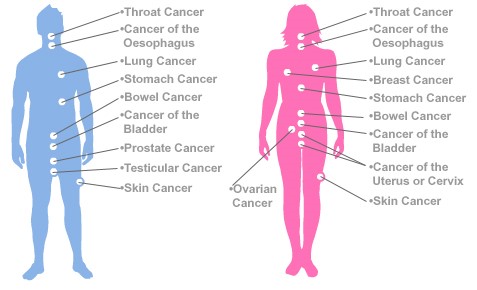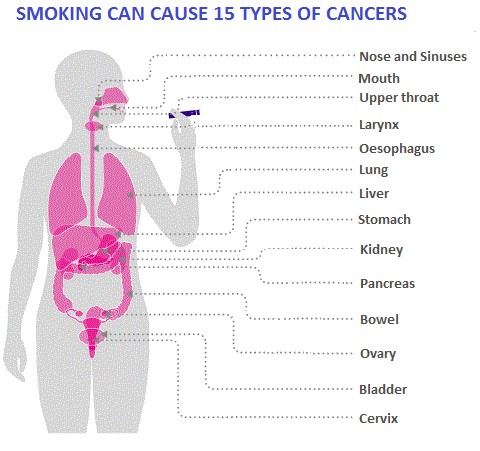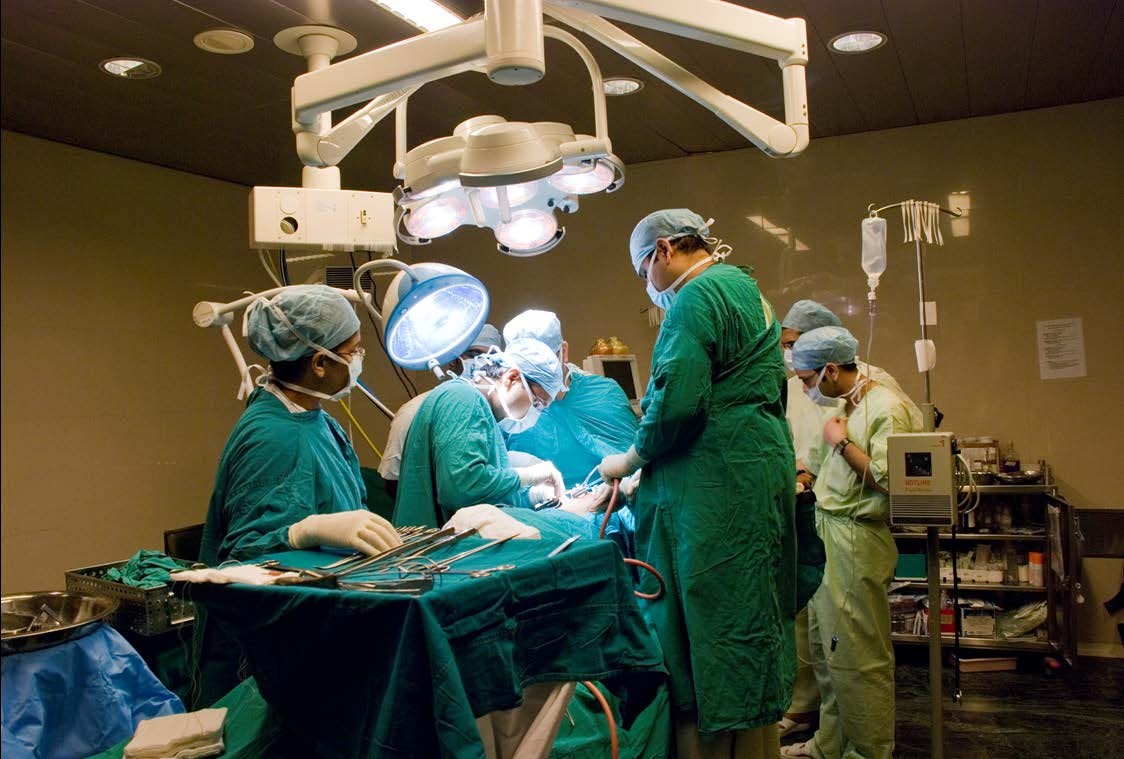कैन्सर की जानकारी
कैन्सर कोशिकाओं के असामान्य विकास से जुड़ी बीमारियों का एक समूह है. किसी भी जांच के बिना, रोग अंततः प्रगति कर सकता है, जिससे पूर्व-परिपक्व मृत्यु हो सकती है। वे शरीर में कहीं भी उत्पन्न हो सकते हैं और सभी आयु वर्ग, सामाजिक-आर्थिक स्तर और जाति के लोगों को प्रभावित कर सकते हैं. कैंसर दुनिया में रुग्णता और मृत्यु दर का प्रमुख कारण है. इंटरनेशनल एजेंसी फॉर रिसर्च ऑन कैंसर के आंकड़ों के अनुसार, दुनिया भर में 2018 में कैंसर से 18.1 मिलियन नए कैंसर के मामले थे, 9.6 मिलियन कैंसर से मौतें हुईं।
Common Cancers
Worldwide, the commonest cancers amongst men are lung, prostate, colo-rectum, stomach, and liver cancer. Among women the most common sites diagnosed are breast, colo-rectum, lung, cervix, and stomach cancer. In India, amongst males, common cancers are lip, oral, esophogus, lung, stomach and colo-rectal cancers. In females, breast, cervix, lip, lung, gastric, ovary and oral cancers are the commonest cancers.
The incidence of these cancers varies according to the geographical area, prevalent social customs and the socio-economic strata. For example, oral cancers are common in Indian sub-continent and not that common in western countries. This is because of higher consumption of chewable forms of tobacco in the form of gutkha, paan, paan masala, khaini, supari etc. Cervical cancers are commoner in women from lower socio-economic strata because of poor genital hygiene. Colo-rectal cancers occur with higher frequency in those consuming more of fatty food and less of fibers in their diet.

Causes of Cancer
Tobacco
Tobacco consumption is the single most important avoidable risk factor for cancer mortality worldwide. According to WHO, it causes an estimated 22% of cancer deaths per year. Majority of the lung cancers are associated with smoking. Passive smoking has also been associated with cancers in non- smoking adults. Risk increases with increasing quantity of smoking. In Indian sub-continent use of smokeless tobacco is more prevalent. These include use of gutkha, pan masala, masheri, raw tobacco, betel quid etc. Tobacco is associated with cancers of lung, oral cavity, throat, oesophagus, urinary bladder, pancreas, kidney, liver, stomach, bowel, cervix, ovary, nose and sinus as well as some types of leukaemia. Tobacco contains over 4000 types of chemicals. Out of these, around 200 are harmful for human body and about 70 different chemicals have been found to be carcinogenic. Various studies have shown that those who quit tobacco have a better survival than those who don’t. About 50% of tobacco users die because of some form of tobacco related disease. A new trend is that of the use of e-cigarettes. They are battery operated LED light containing devices which light up when used and release nicotine. They have been falsely advertised as safer alternative to cigarettes. Many studies have been conducted upon the safety of these e-cigarettes. They have been found to be associated with persistent throat irritation, seizures, pneumonia and heart failure. They contain nicotine which is highly addictive and is itself carcinogenic. Their fumes also have been found to have tobacco specific nitrosamines and other harmful chemicals. Various countries have banned or restricted the sale of such devices.

Alcohol
Alcohol itself is associated with several cancers, the risk of which increases with increasing quantity of alcohol consumed. It has synergistic action along with smoking and if a person consumes alcohol and tobacco then the risk of developing cancer is much higher than the risk associated with consuming them independently. Alcohol use is a risk factor for many cancer types including cancer of the oral cavity, pharynx, larynx, oesophagus, liver, colo-rectum and breast.

Areca Nut
It is also called as supari in India. It may be chewed alone or in combination with betel leaf, catechu and slaked lime – called as Pan or betel quid. Powdered areca nut in ready to eat mixtures with other ingredients is called Pan Masala. If tobacco is added to these then it is called Gutkha. It is associated with Sub Mucous Fibrosis which is a pre-cancerous condition where the mouth opening of the chewer decreases gradually. It has been included as a group I carcinogen by The International Agency for Research into Cancer (IARC). Its use has been found to lead to oral cancer. It may also result in cancers of liver and pancreas.

Pollution
This includes the environmental pollution of air, water and soil with carcinogenic chemicals. Exposure to these chemicals can occur through air and drinking water. Chemicals like arsenic cause contamination of drinking water and can result in lung cancers. Household air is polluted by coal fires and cause lung cancer. Besides, contamination of food with aflatoxins can also cause cancer.

Obesity
It refers to excessive fat accumulation. If body mass index (BMI) is above 25 kg/m2, the person is called overweight. Those having BMI over 30 are called obese. It is associated with increased risk of heart diseases, diabetes and cancer like those of endometrium, colon, breast, esophagus, pancreas etc. Besides increasing the risk of developing such cancers, obesity is also associated with increased chances of deaths due to such cancers. Proper healthy diet and regular exercise are required to curb the menace of obesity.
Occupational exposure
Several cancers are seen to have higher association with specific occupations. Substances like asbestos, cadmium, ethylene oxide, benzopyrene, silica, ionizing radiation including radon, tanning devices, aluminum and coal production, iron and steel founding, have been found to be associated with various cancers. These are important to know because with adequate knowledge and precautions most of these cancers can be prevented. Common cancers associated with occupational exposure include lung, bladder, leukemia, skin etc. Radiation including UV rays - Ultraviolet radiation is associated with skin cancers like basal cell carcinoma, squamous cell carcinoma and melanoma. Exposure to ionizing radiation has been associated with increased risk of several cancers. This has been extensively studied in survivors of atomic bomb in Japan.
Biological agents
These include various viruses, parasites and bacterial infections which predispose the patient to develop certain cancers. Human papilloma virus (HPV) is associated with cervical cancers and oropharyngeal cancers. Hepatitis B and C are associated with liver cancers. Parasitic (Schistosomiasis) infection is associated with increased risk of bladder cancer. Helicobacter pylori (H. pylori) infection may results in stomach cancer. These infections can be prevented with precaution, vaccination and early diagnosis and treatment.
Genetic predisposition – In many situations, cancer is a genetic disease i.e., cancer is caused by certain changes to genes that control the way our cells function, especially how they grow and divide. Genetic changes that predispose to cancer usually are inherited from our parents. Such changes, called germline changes, are found in every cell of the offspring. Rarely, such changes can happen during the process of reproduction.
Screening for Cancer
Screening refers to identification of a disease in an individual who has not yet developed its signs and symptoms. In this, simple tests are conducted on general population or a high risk group to identify the individuals harbouring the disease. In this way, the affected individual can be identified before he/she presents with the symptoms of the disease. Screening helps in early identification and diagnosis of several cancers. Identifying these cancers early means a better possibility of control over the disease. Screening is a useful tool in early detection of cancers of breast, cervix, oral cavity and colo-rectum.
Breast cancer
Screening for breast cancer is done with mammography. Mammography refers to taking an x-ray image of the breast. Its efficacy as a screening test has been proven in several studies and it helps in reducing the morbidity and mortality associated with breast cancer. It should be done regularly in individuals having family history of breast cancer. Self-examination of breast can also help the woman to become aware about swelling in breast.

Cervical cancer
Pap smear is used to screen women for cervical cancer. In this a smear taken from the cervix is examined under microscope to look for pre-cancerous or cancer cells. It is a cost effective method of screening. It is advisable for all women above the age of 35-40 years to undergo Pap smear examination. Besides this, visual inspection of the cervix with acetic acid application is also done at several places.

Oral cancers
Screening for oral cavity cancers is relevant because of easy accessibility of oral mucosa for visual inspection without requiring any special equipment or expertise and the fact that most of the oral carcinomas are preceded by visible pre-cancerous lesions. Commonly seen pre-cancerous lesions include leukoplakia and erythroplakia. Leukoplakia refers to a whitish patch in oral cavity, for the presence of which no other cause can be found. A similar reddish patch is called erythroplakia. Biopsy from these suspicious areas may be taken to rule out malignancy.
Clinical photograph of the oral cavity of a tobacco chewer, smoker showing pre- cancerous and cancerous lesion.

Colo-rectal cancers
Screening for these cancers is directed at people with family history of similar cancers or in those suffering from conditions like inflammatory bowel disease where there are higher chances of developing malignancy. Presence of occult blood (not visible grossly) is tested for in faces and in certain cases colonoscopy is also done.
Cancer Treatment
Surgery
When used to treat cancer, surgery is a procedure in which a surgeon removes cancer from body. Surgeons are medical doctors with highly specialized training in surgery; surgeons often use small, thin knives, called scalpels, and other sharp tools to cut the part of body during surgery. Surgery often requires cuts through skin, muscles, and sometimes bone. After surgery, these cuts can be painful and take some time to recover from. Anaesthesia keeps the patient from feeling pain during surgery.
There are other ways of performing surgery that do not involve cuts with scalpels. Some of these include:
Cryosurgery
Cryosurgery is a type of treatment in which extreme cold produced by liquid nitrogen or argon gas is used to destroy abnormal tissue. Cryosurgery may be used to treat early-stage skin cancer, retinoblastoma, and precancerous growths on the skin and cervix. Cryosurgery is also called cryotherapy.
Lasers
This is a type of treatment in which powerful beams of light are used to cut through tissue. Lasers can focus very accurately on tiny areas, so they can be used for precise surgeries. Lasers can also be used to shrink or destroy tumours or growths that might turn into cancer. Lasers are most often used to treat tumours on the surface of the body or on the inside lining of internal organs.
Surgery may be open or minimally invasive.
In open surgery, the surgeon makes one large cut to remove the tumour, some healthy tissue, and maybe some nearby lymph nodes. In minimally invasive surgery, the surgeon makes a few small cuts instead of one large one. Surgeon inserts a long, thin tube with a tiny camera into one of the small cuts. This tube is called a laparoscope. The camera projects images from the inside of the body onto a monitor, which allows the surgeon to see what is going on inside and what is next step of procedure. The surgeon uses special surgery tools that are inserted through the other small cuts to remove the tumour and some healthy tissue. Because minimally invasive surgery requires smaller cuts, it takes less time to recover from than open surgery.
Surgeons are highly trained and will do everything they can to prevent problems during surgery. Even so, sometimes problems do occur. Common problems are:
Pain – After surgery, most people will have pain in the part of the body that was operated on. How much pain a person feels will depend on the extent of the surgery, the part of the body where surgery was performed.
Infection – Infection is another problem that can happen after surgery. To help prevent infection, follow nurse’s instructions about caring for the area where patient had the surgery. If patient develops an infection, doctor can prescribe a medicine (called an antibiotic) to treat it.

Radiation Therapy
Radiation therapy is a type of cancer treatment that uses high doses of radiation to kill cancer cells and shrink tumours. At high doses, radiation therapy kills cancer cells or slows their growth by damaging their DNA. Cancer cells whose DNA is damaged beyond repair stop dividing or die. When the damaged cells die, they are broken down and removed by the body. Radiation therapy does not kill cancer cells right away. It takes days or weeks of treatment before DNA is damaged enough for cancer cells to die. Then, cancer cells keep dying for weeks or months after radiation therapy ends.
Types of Radiation Therapy – There are two type of radiation therapy that depends on many factors, including:
- The type of cancer
- The size of the tumour
- The tumour’s location in the body
- How close the tumour is to normal tissues that are sensitive to radiation
- General health and medical history of the patient
- Other factors, such as age and other medical conditions
External Beam Radiation Therapy – External beam radiation therapy comes from a machine that aims radiation at cancer. The machine is large and may be noisy. It does not touch the body, but can move around, sending radiation to a part of patients’ body from many directions. External beam radiation therapy is a local treatment, which means it treats a specific part of body. For example, if one has cancer in the lung, the patient will have radiation only to chest, not to the whole body.
Internal Radiation Therapy – Internal radiation therapy is a treatment in which a source of radiation is put inside the body. The radiation source can be solid or liquid. For some people, radiation may be the only treatment. But, most often, patient will have radiation therapy with other cancer treatments, such as surgery, chemotherapy, and immunotherapy. Radiation therapy may be given before, during, or after other treatments to improve the chances that treatment will successfully eradicate / control the cancer.

Chemotherapy
Chemotherapy is a type of cancer treatment that uses drugs to kill cancer cells. Chemotherapy works by stopping or slowing the growth of cancer cells, which grow and divide quickly.
Chemotherapy is used to:
Treat cancer – Chemotherapy can be used to cure cancer, lessen the chance it will return, or stop or slow its growth.
Ease cancer symptoms – Chemotherapy can be used to shrink tumours that are causing pain and other problems.
Who Receives Chemotherapy – Chemotherapy is used to treat many types of cancer. For some people, chemotherapy may be the only treatment. But most often, patient will have chemotherapy and other cancer treatments. The types of treatment that patient need depends on the type of cancer and in which parts it has spread and where, and does the patient have other health problems.
How Chemotherapy Is Used with Other Cancer Treatments
When used with other treatments, chemotherapy can:
- Make a tumour smaller before surgery or radiation therapy. This is called neoadjuvant chemotherapy.
- Destroy cancer cells that may remain after treatment with surgery or radiation therapy. This is called adjuvant chemotherapy.
- Help other treatments work better.
- Kill cancer cells those have returned or spread to other parts of body.
Chemotherapy Can Cause Side Effects – Chemotherapy not only kills fast-growing cancer cells, but also kills or slows the growth of healthy cells that grow and divide quickly. Damage to healthy cells may cause side effects, such as mouth sores, nausea, and hair loss. Side effects often get better or go away after the final cycle of chemotherapy.
mmunotherapy and targeted therapies.
Immunotherapy is a very novel type of systemic therapy which works differently from how chemotherapy works. Basically it works by stimulating the cells of the immune system to effectively eradicate / kill cancer cells. The side effects caused by immunotherapy are significantly different from those caused by conventional chemotherapy. The use of immunotherapy is increasing with its effectiveness being tested and proven in several cancers.
Apart from chemotherapy and immunotherapy, targeted therapies are yet another systemic therapy. These drugs target specifically the cancer cells, and spare the normal tissues. Their adverse effects are also different from those of chemotherapy.
Cancer Prevention
First and foremost comes
Cessation of tobacco consumption. Tobacco is the single most important cause of deaths related to cancer in up to 20% of people. One should stay away from both chewable as well as non-chewable forms of tobacco.
Alcohol cessation – Healthy lifestyle – regular physical activity along with diet rich in fruits and vegetables help in reducing the chances of developing cancer.
Apart from chemotherapy and immunotherapy, targeted therapies are yet another systemic therapy. These drugs target specifically the cancer cells, and spare the normal tissues. Their adverse effects are also different from those of chemotherapy.
Good genital hygiene
Maintenance of good genital hygiene along with safe sexual practices reduce the risk of infection with Human Papilloma Virus (HPV) and decrease the risk of developing cervical and oropharyngeal cancer. Vaccination against HPV infection is also available for adolescent girls.
Curbing pollution
Reduction of both household and outdoor pollution helps in reduction of risk of cancer. Household pollution with fossil fuels like coal can result in lung cancer. Outdoor pollution includes contamination of both air and water with various carcinogens.
Work place precautions
Those involved in occupations associated with exposure to carcinogenic compounds or radiation should be provided adequate protection and should be examined at regular intervals.
Hepatitis B Virus infection
Can result in liver cancer. Proper precautions should be taken to prevent the spread of infection through infected blood products. Vaccination against Hepatitis B virus is also available and its full dose should be taken.
Family history
Those with a family history of breast, thyroid, and colo-rectal cancer should be aware of risk associated with their developing cancer. They should have themselves examined by a doctor and should be aware of the early signs of cancer.
Vaccination
Vaccines, Which are also called immunizations or inoculations, are used to help a person’s immune system recognize and fight certain infections or diseases. People with weak immune systems can get some vaccines, but they should not get any vaccines that contain live virus. Fatal infections have been caused by giving live-virus polio, measles, and smallpox vaccines to people with weak immune function.

